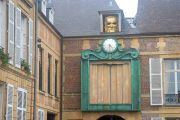A two-faced city, Charleville-Mézières boasts one of Europe’s most beautiful Renaissance squares and perpetuates the memory of poet Arthur Rimbaud. It’s also an important puppetry centre hosting an international festival every two years.
[ Practical ]
Getting there
- By road
235 km from Paris on autoroute A4 till exit 26 then on N51, A43 and N34 till Charleville-Mézières.
- By train
TGV from Paris Gare de l’Est to Charleville-Mézières or TGV from Paris Gare de l’Est to Reims then TER from Reims to Charleville-Mézières. The journey takes between 1 hour 40 mn and 2 hours.
Lodging
Le Pélican
Le Dormeur du Val
Hôtel Kyriad
Hôtel Le Clèves
Restaurants
La Clef des Champs
Le Lard des Mets
La Papillote
Sel et Poivre
La Table d’Arthur
Musée Rimbaud and Maison des Ailleurs
Open every day except Monday from 10am to noon and from 2pm to 6pm.
Admission : €4 / €2.
Tel : 0324324465
Puppet Festival
2015 edition from September 18th to 27th
www.festival-marionnette.com
Information
- Ardennes Tourist Office
Tel : 0324566773
www.ardennes.com
- Charleville-Mézières Tourist Office
Tel : 0324556990
www.charleville-mezieres.org
Nested in a meander of the Meuse, near the entrance of the gorges of this river, Charleville-Mézières – the Ardennes prefecture – is a young city. Indeed, it was only founded in 1966 from the merger of the towns of Charleville and Mézières that were only separated by an arm of the river. In spite of its short history, it welcomes visitors from all over the world because Arthur Rimbaud was born in Charleville in 1854 and spent his youth there.
 Two museums dedicated to Rimbaud Two museums dedicated to Rimbaud
Sometimes critical of his birthplace, the poet prodigy with precocious talent nevertheless always came back there after he ran away or between his numerous wanderings throughout Europe. He also died there, in 1891, after spending the last years of his life in Ethiopia where he was a trader and sometimes smuggled weapons. A tumultuous and adventurous life that retraces the Rimbaud museum through period photographs, objects, drawings, documents and even original manuscripts of some of his poems. Besides, the house where he lived with his family has been turned into another museum dedicated to his memory : the Maison des Ailleurs. But don’t expect to discover the place as it looked in the 19th century. Only one room keeps its original appearance. In the other ones, twelve contemporary artists evoke his travel and his poems through installations mixing modern objects, light effects and image screenings.
 A superb Renaissance square A superb Renaissance square
His admirers can also pay a visit to his grave located in the town old cemetery and follow in his footsteps thanks to a few interactive kiosks set up in front of places he used to go.
All are located in Charleville that was built from nothing in the early 17th century by the will of Charles de Gonzague. Once, one of the most powerful dukes in France, he dreamed to create an ideal city and put a young architect in charge of this project: Clément Métezeau whose brother just conceived of the Place des Vosges in Paris. So it’s not surprising that this square is somehow bit similar to the Charleville’s gem, the Place Ducale, a vast esplanade surrounded by twenty-four buildings with arcades made up of ochre stones and red bricks whose ground floors are like in the past often occupied by shops or restaurants. The surrounding neighbourhood street grid pattern is dotted with many other fine buildings such as the former ducal mill, adorned with ionic columns, that houses the Rimbaud museum.

 Banks of the Meuse © T.Joly Banks of the Meuse © T.Joly
|
 Abstract stained glass windows Abstract stained glass windows
It stands along the river Meuse at the entrance of one of the many parks of the city. Lastly, those interested can have a look at the Musee de l’Ardenne that contains archaeology, weapons and coins collections;
Once a powerful military fortress now dismantled, Mézières suffered a lot during the wars between France and Germany and has less charm. It nevertheless keeps some remains of its ramparts, the former Army Engineer School, an 18th century classic building now the prefecture, and a beautiful cathedral, the Basilique Notre-Dame de l’Espérance. Built during the 16th and 17th centuries, it is lighted by beautiful abstract stained glass windows designed by René Dirrbach, a friend of Picasso.
A little-known fact, Charleville-Mézière is also France’s capital of puppetry. The city owes this status to a man, Jacques Felix, who first founded a puppet company in 1945, before launching in 1972 an international festival that grew in importance over the years.

 The Great Puppeteer © T.Joly The Great Puppeteer © T.Joly
|
 The Great Puppeteer The Great Puppeteer
Charleville-Mézières has thus become one of the world main centres for puppet art and now hosts several major puppetry institutions. UNIMA, the international representative organisation for puppeteers, an NGO affiliated to UNESCO. The National High School of Puppetry that welcomes teachers and students from all countries. The International Institute of Puppetry that is both a research and documentary centre as well as a theatre. Located on Winston Churchill Square, it is easily identifiable as its façade is adorned with an automaton, “The Great Puppeteer” that performs a short puppet show every hour. As to the festival, it now takes place every two years and enjoys a worldwide fame. For about ten days, more than 150 companies coming from the five continents give performances in about forty venues. A good time to visit the city.
August 30, 2015
Thierry Joly 

|



